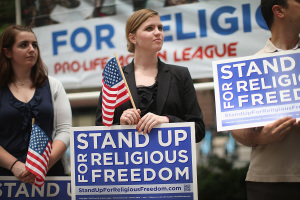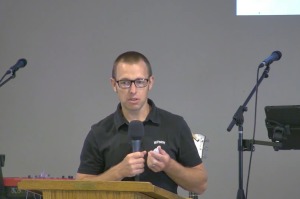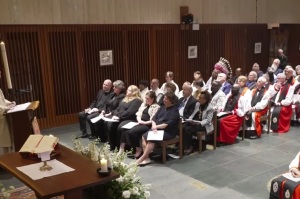Green-Lettered Bible Preaches Creation Care
The Green Bible, which highlights verses and passages that speak of God's care for creation in green ink, is the latest eco-friendly Scripture to hit the market.
You won't find a genuine leather cover, high-grade paper pages, the satin ribbon bookmark, or even Jesus' words printed in red letters.
Instead, the New Revised Standard Version Bible by HarperOne is clothed with a cotton linen cover and carries text printed on recycled paper using soy-based ink.
The Green Bible, released earlier this month, comes one year after Bible-publishing giant Thomas Nelson released the first Forest Stewardship Council certified Bible. But what makes The Green Bible unique is that it contains over 1,000 references to creation care that are printed in a forest shade of green.
For example, Genesis 1:31: "God saw everything that he had made, and indeed, it was very good," is printed in green lettering. In fact, most of Genesis 1 and 2 is highlighted in that color.
Numbers 35:33-34 is also in green, reading, "You shall not pollute the land in which you live…you shall not defile the land in which you live, in which I also dwell; for I the Lord dwell among the Israelites."
"The Green Bible is the first-ever specialty Bible that takes the issues of sustainability, stewardship of the earth, what many in the religious community call creation care," said publisher Mark Tauber. "I think it will surprise a lot of people of faith."
The book includes a forward by Archbishop Desmond Tutu and essays by a variety of religious leaders including Pope John Paul II; Brian McLaren, a proponent of the emerging church movement; and N. T. Wright, Anglican Bishop of Durham.
"The Green Bible is the definitive movement Bible that shows that God is green and how we can care for and protect God's creation," the publisher describes in its website.
Some Christians say highlighting verses that pertain to the planet in green is not enough to cast creation care as a central theme of the Bible.
Others are puzzled why verses like Revelation 19:20, which reads "These two [beasts] were thrown alive into the lake of fire that burns with sulfur," made the cut of verses emphasized in green.
Brandon O'Brien, assistant editor of Leadership magazine, expressed concern that the green text could distract readers from the theological significance of the passages.
"I believe the Bible does challenge us to be better stewards of the planet. But I wonder if color-coding certain biblical themes disintegrates—rather than integrates—the unity of the gospel message by dividing the text into specialized issues," he writes on his blog.
While mainline Protestants have long embraced ideals on environmental stewardship, evangelical Christians have only more recently followed suit with 90 percent now saying they would like to see Christians take a more active role in caring for God's creation, according to a recent Barna study. However, only 27 percent firmly believe global warming is occurring.
The evangelical perception on global warming can look different depending on where one looks.
The Rev. Richard Cizik, vice president of the National Association of Evangelicals, is a fervent leader in the green evangelical movement. Through partnership programs between NAE and the U.S. government, Cizik has encouraged churches to help cut greenhouse emissions by making their worship facilities more energy efficient.
On the other side of the spectrum stand leaders including Richard Land, head of the public policy arm of the Southern Baptist Convention. Earlier this year, Land and other evangelicals sent a letter to Congress, urging them to reject legislation that sought to enforce a cap-and-trade system on power plants, large manufacturers and the transportation sector, requiring them to pay to pollute.
Theological differences aside, some readers like the overall feel and utility of the Green Bible.
"I know many people will find theological fault with this Bible but I challenge those who do to actually pick one up and see what they think," reviews reader O. Arauz on Amazon.com. "I think you'll be pleasantly surprised and perhaps not so judgmental."
The Rev. Ben Daniel at Foothill Presbyterian Church in San Jose, Calif., said he plans to use the green-lettered Bible as a "teaching tool" for his congregation. In 2003, his church made it a "business" to go green in Santa Clara County.
The Green Bible has received endorsements from Sierra Club, The Humane Society of the United States, and the Eco-Justice Program office of the National Council of Churches, among others.




























